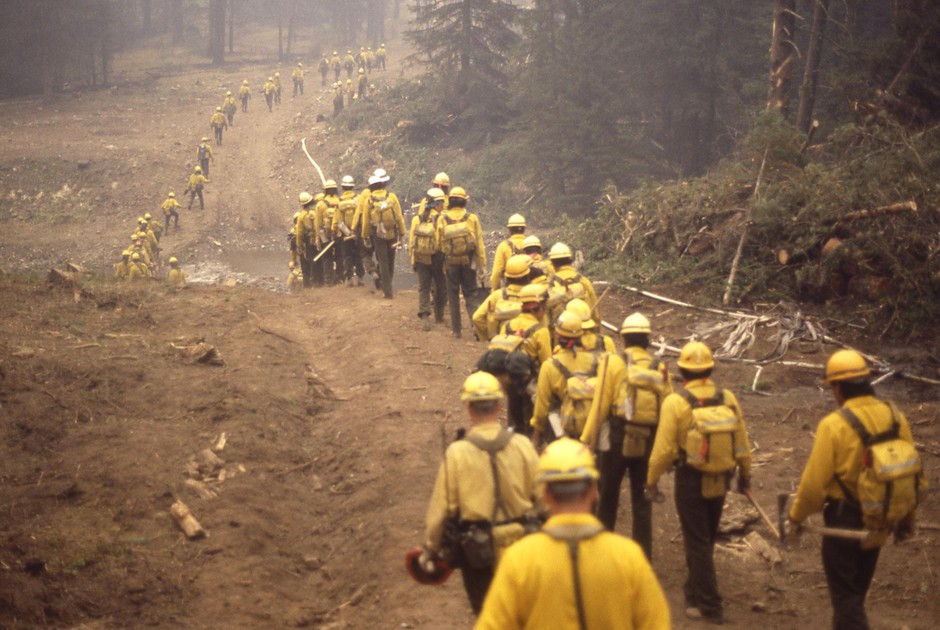
Not Enough Is Known About Smoke’s Effect On Wildland Firefighters’ Health
Listen
When Timothy Ingalsbee thinks back on his days in the 1980s and 90s fighting wildfires in the Pacific Northwest, he remembers the adventure of jumping out of a helicopter into the wilderness.
“Ideally we’d have at least one skid touching the steep slope,” he recalled.
There was the camaraderie of sleeping with his crew out under the stars or smoke-filled skies. And then there were the colors.
“I had amazing vistas of crimson red sunsets over the mountains,” he said.
But Ingalsbee, who went on to found the Eugene-based Firefighters United for Safety, Ethics and Ecology, doesn’t want to remember everything.
“I tried to forget about all the forests I inhaled,” he said. “I remember some seasons, I just had been so impacted by this smoke. I lost my sense of smell and taste for several months. It wasn’t until maybe the next spring is started coming back.”
Over the past few years, Pacific Northwest communities have been getting better acquainted with wildfire smoke. The issue has become a political, economic and public-health lightening rod. But even in the most affected places, people can get some relief by limiting time outside and using air filters and inexpensive masks.
These aren’t options for wildland firefighters. They endure smoky conditions rarely experienced in communities. It’s an occupational hazard scientists and fire agencies are just beginning to understand.
Sucking Smoke
Every firefighter, by the nature of their work, faces smoke.
“People are now aware that they probably shouldn’t stand in the smoke if they don’t have to,” said Mike DeGrosky, Fire Protection Bureau chief with the Montana Department of Natural Resources and Conservation. “People know to minimize smoke exposure out on the line when people are working. But the reality is they work in a very, very smoky environment that smoke has lingering health effects.”
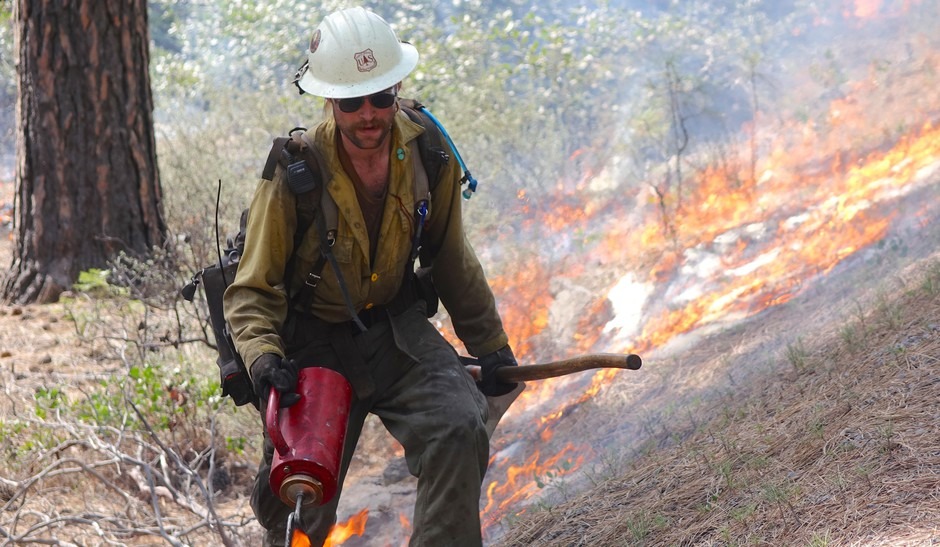
A member of the Wolf Creek Hotshots uses a drip torch to ignite the forest floor during a prescribed burn near Sisters, Oregon. CREDIT: JES BURNS/OPB
This is where DeGrosky’s frustration comes in.
“I don’t think we’ve really looked at the long-term — for example, cancer consequences of chronic smoke exposure — like the structural fire world has,” he said.
Rick Swan, director of health and safety occupational services for the International Association of Firefighters and a 30-year veteran of CalFire, says studies have shown negative health impacts for structural firefighters: cancer, heart and lung disease, and even mental health issues.
But wildland firefighters have largely been left out of the research.
“Everyone used to say, ‘It’s just a barbecue fire. It’s just, you know, wood. It’s no big deal,’” he said.
Now it’s known that forest fire smoke is full of compounds and components that are regulated by the Environmental Protection Agency.
Wildland firefighters and crews working prescribed burns are exposed to fine particulate matter that can absorb deep into the lungs. They breathe carbon monoxide that can cause a significant and immediate loss in cognitive function.
In addition, there are a host of other toxins such as acrolein, nitrogen dioxide, benzene and formaldehyde in the smoke, as well as the potential for exposure to smoke laced with chemicals from herbicides that were applied to forests before they caught fire.
Researchers with the U.S. Joint Fire Science Program have found that workers holding fire lines and working mop-up after a fire has burned through are exposed to the highest levels of particulate matter.
And the smoke exposure often doesn’t end at the fire.
“Some of the worst air can be in fire camp — where you’re supposed to go for rest,” Ingalsbee said.
Often the camps that house and feed fire workers and support personnel are located in valley bottoms, where wildfire smoke often gets trapped.
“You wake up in fire camp with people coughing and hacking up. They call it camp crud,” he said.
On top of often not being able to escape smoky conditions, wildland firefighters have limited personal gear for respiratory protection.
“This is 2019. We’ve been using a bandana for I don’t know how many decades? And that is the best we have to offer?” Swan said. “The bandana is our respiratory protection.”
A bandana is the only respiratory protective equipment recommended for firefighters to carry. And the EPA and many other health agencies warn that they don’t actually help reduce particulate exposure.
The issue is more complicated than that – when it comes to respiratory protection in the field – firefighters are damned if they do, damned if they don’t.
“Increasingly, we look at wildland firefighters as tactical athletes. Their respiratory demands are similar to those people engaging in athletic events.” DeGrosky said. “You put any kind of restrictive thing over your nose and mouth and you’re decreasing your oxygen update, which decreases your muscle abilities, your cognitive abilities.”
The basic N95 respirators available to the general public don’t hold up to the intense, physical conditions on a fire, and the respirators that structural firefighters use are heavy, reduce vision and can only supply clean air for a short period of time. Wildfire shifts are generally 12 hours.
Looking Long Term
It hasn’t been until recently that federal fire agencies have started considering what the long-term health effects of all this smoke exposure could be.
A 2017 review of research on wildfire smoke exposure by the Joint Fire Science Program observed that “the effects of chronic exposures experienced by the wildland firefighter are largely unknown,” although an analysis done as part of the review did indicate “inhaled particulate matter can increase the risk of premature mortality from heart disease or cancer” for wildland firefighters.
Wildland firefighters are a difficult group to study, in part because of the nature of the work itself. They often work seasonally or part-time. The work is physically demanding, a “young person’s job,” and many don’t stick with it long term.
Also, there’s not a convincing analog in other lines of work for the conditions wildland firefighters experience. They work long hours at a high level of physical exertion.
“We know that wildland firefighters experience a range of exposures, not just smoke but disruptive disrupted sleep, working under intense conditions, and difficult terrain,” said Curtis Noonan an epidemiologist at the University of Montana. “And so we know all of these exposures are associated with health outcomes, but they just haven’t been looked at yet for wildland firefighters.”
Noonan and his colleague Erin Semmens are researching some of these health outcomes.
“What does fighting fires season after season, year after year do to the long-term health of a firefighter? We’re specifically interested in respiratory health and cardiovascular health, as well as hearing,” said Semmens.
Interior Department firefighters are required to undergo an extensive physical every three years. The researchers are using these medical records and employment data showing how many days and years firefighters have been working on fires to determine if there’s a link.
“So if they’re seeing some cardiovascular impacts, maybe that is something that needs to be screened more frequently,” said Semmens.
But these are early days for the research – they’re less than a year into a two-year investigation. Semmens says if their work establishes a positive association for between on-the-job exposures and long term health impacts, it could help justify a deeper look at the issue.
In the meantime, wildland firefighters are facing another fire season.
Culture Shift
When it comes to wildland firefighter health, change is happening at a frustratingly slow pace for Swan, the union safety director.
“A lot of folks are sticking their heads in the sand. And just calling this all …no big deal,” he said, adding that not enough attention is given to the smoke exposure fire crews experience on prescribed burns.
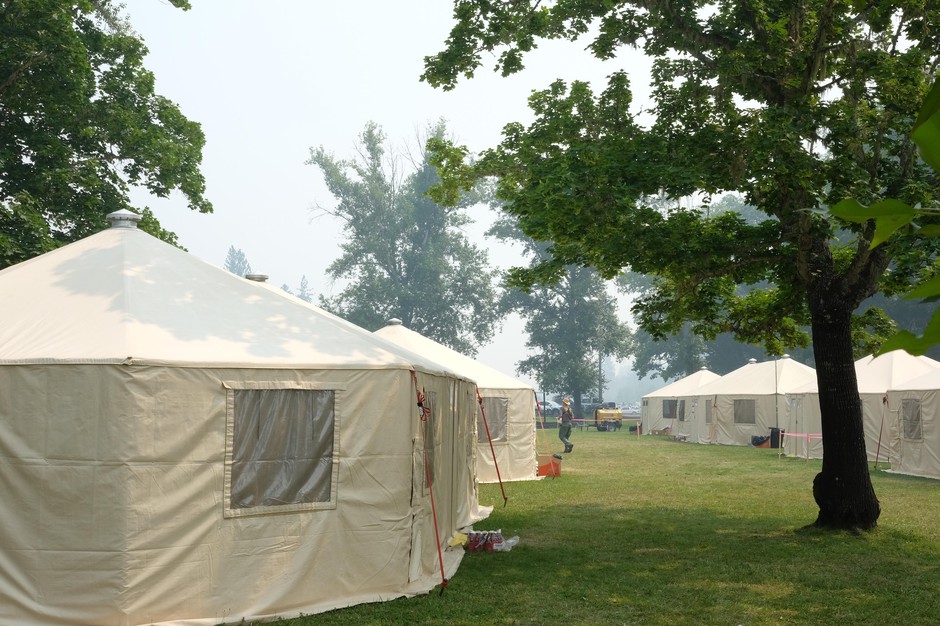
For every major fire, a small city must be set up to support the firefighting effort. Air-conditioned yurts house the command team setting up a communications network, medical facilities, weather forecasting, finance, etc. CREDIT: SAGE VAN WING/OPB
Fire scientists with the Joint Fire Science Program, which includes the U.S. Forest Service as a member, have found that prescribed fire crews’ exposure to particulate matter (PM4) is are likely to exceed occupational exposure limits recommended by the National Wildfire Coordinating Group (of which, the USFS also is a member).
OPB was denied access to a U.S. Forest Service prescribed burn near Ashland after disclosing to officials that it was working on a story about the health effects of smoke exposure on crew members.
In addition, Swan says he’s seen a general reluctance to take on the issue of respiratory protection for firefighters out in the field.
“We …go, ‘We’re just going to go ahead and keep doing what we’re doing because we don’t really have any other choice,’” he said.
Swan says it’s indicative of a wildland firefighting culture that is stuck in the past – one that preserves a glorified image of the “real” firefighter: dirty and willing and able to work long hours, despite what it may be doing to their long term health.
“In the fire service, they have this thing called LCES – Lookouts Communications Escape Routes and Safety Zones – that’s built into our head. The problem… is that we’ve kind of taken that LCES to (be) ‘Look Cool Every Second,’” Swan said. “That culture gets us into trouble more than anything. It doesn’t allow us to get out of our own way.”
Despite these concerns, things are slowly changing when it comes to protecting wildland firefighter health.
For the first time this year, the national group responsible for developing wildfire training materials has included a unit on the dangers of smoke exposure as part of its annual health and safety refresher course.
“A large portion of these, especially these introductory classes, are very oriented on safety. That’s something that’s ingrained in firefighters from their first day on the job,” said Jessica Gardetto, a spokesperson for the National Interagency Fire Center.
Gardetto says the National Wildfire Coordinating Group is currently updating the curriculum for the introductory classes to include information about the risks of smoke exposure.
Earlier this year President Trump signed legislation to create a “national firefighter registry” that will help the Centers for Disease Control track links between on-the-job exposures and cancer. Congress appropriated $1 million dollars to implement the program.
The international firefighters union says it’s working with the government to ensure that the term “firefighter” is applied as loosely as possible so it includes wildland firefighters.
The Backstop
Ingalsbee, the former Northwest wildland firefighter, says he doesn’t regret his time working wildfires and dealing with that smoke, even though he’s observed his own lung capacity suffer significantly since leaving the woods.
But he predicts it will take more than a shift in training to make sure wildland firefighters are protected — not only on the job but long after their careers have ended.
“Veterans of military conflict get health services long after they’re out of uniform. Perhaps our ‘wildfire warriors’ should be provided health services after they’re out of uniform,” he said.
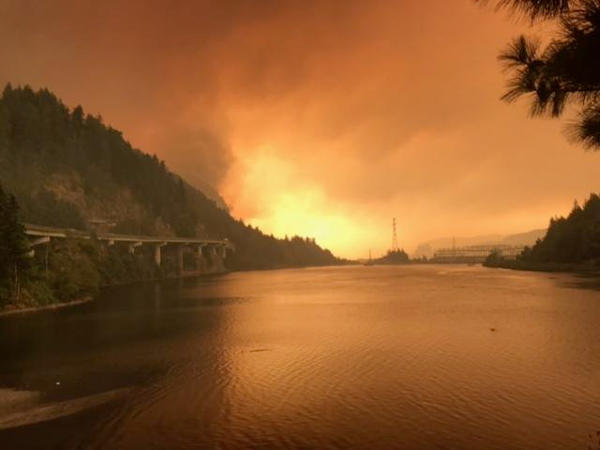
Smoke from the Eagle Creek Fire hovers over the Columbia River Gorge, Sept. 4, 2017. CREDIT: INCIWEB
While this kind of comprehensive care isn’t guaranteed for wildland firefighters, there are state occupational safety laws that could help act as a sort of insurance policy against long-term health impacts of the job.
The protections are called “presumptive illness” laws. They’re designed to remove the burden of proof in workers compensation cases for firefighters and other first responders that develop certain diseases. If certain conditions are met, the illnesses are simply presumed by the states to be the result of on-the-job exposures.
Most states have presumptive laws that cover municipal/structural firefighters, but coverage for wildland firefighters is often not guaranteed.
For example in Oregon, firefighters need to work five years to be covered. It’s unclear whether five years of seasonal employment would qualify a wildland firefighter for presumptive consideration. The Oregon Workers’ Compensation Division says it would be “up to the insurer to determine if this criterion is met,” and currently there is no case law governing this question.
In addition, federal wildland firefighters based in Oregon aren’t covered. Neither would volunteer firefighters be in most cases.
Washington’s presumptive law requires firefighters to be full-time employees in order to get coverage.
“On a national level, I would really like to see presumptive illness legislation for wildland firefighters that says if you develop certain kinds of cancer later in life that there will be a presumption that that was work-related,” says Montana fire chief Mike DeGrosky.
On the federal level, only first responders involved in the 2011 terrorist attacks have presumptive illness protections.
Legislation has been introduced this year in the U.S. House to establish presumptive illness protections for federal firefighters, including wildland firefighters, but no action has been taken to move it forward.
For IAFF’s Swan, the lack of science linking wildland firefighter exposure to long term health problems is a hurdle to broader inclusion in presumptive illness laws.
“While we want to be careful of not just throwing presumptive out there willy-nilly, we know that folks are being exposed,” he said.
But the best case scenario would be avoiding the backstop altogether.
“We don’t want you to have to (rely on) these presumptive laws. We want to try to do the best we can on the front end to protect you.”
Editor’s note: Reporting for this story was supported by the Institute for Journalism and Natural Resources.
Copyright 2019 Oregon Public Broadcasting. To see more, visit opb.org
Related Stories:

Protecting farmworkers: Wenatchee nonprofit provides resources amid heat waves, wildfire season
CAFÉ volunteers prepare boxes of supplies for agricultural workers, ensuring community support during extreme weather conditions. Pictured left to right, Yesenia Perez Ana Sanchez, Angelica Garcia-Macias, Joanna Sanchez, and Stephanie
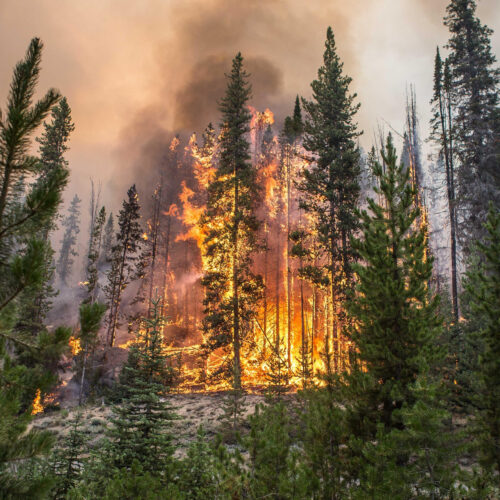
Red Flag Warning: What does it mean?
In this Wednesday, Aug. 7, 2019, photo released by the U.S. Forest Service flames from the Nethker Fire engulf trees at Payette National Forest near McCall, Idaho. The Northwest has
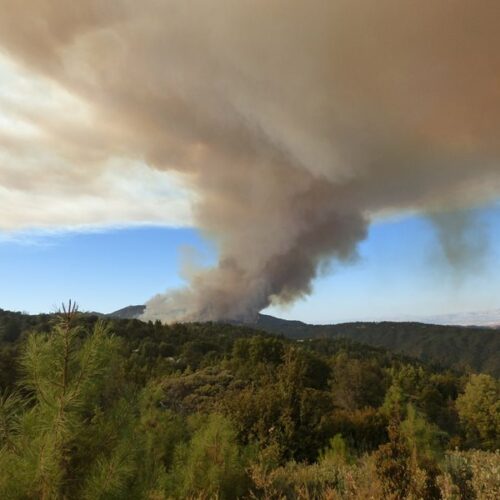
Study: farmworking parents need more resources to cope with wildfire seasons
Farmworkers’ families in Central Washington need more smoke safety information, accessible childcare, and other resources to be prepared for future smoke events. Those are the results of a recent study where researchers asked parents how they cope with wildfire seasons.

